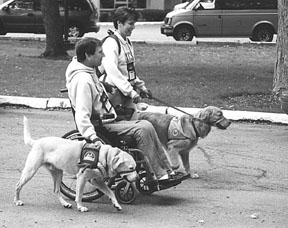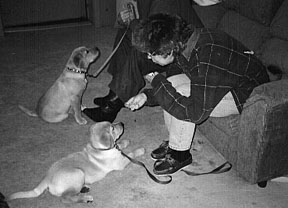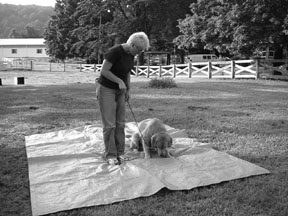Have you ever watched an assistance dog work? On the campus of the Virginia university where I attended graduate school, I often crossed paths with a student who used a wheelchair, accompanied by her assistance dog, a lovely Golden Retriever. They went to classes, visited the snack bars and cafeteria, hung out in the student lounges, and hoofed it all around campus together.
The assistance dog opened doors, picked up dropped items, pressed elevator buttons, and accompanied her owner everywhere. When you approached her owner, the dog looked confidently and calmly right into your eyes. She was the kind of take-anywhere canine companion that any dog lover would be proud to call her own.

What, I wondered, could this assistance dog and her trainers, teach family dogs and their owners about the secrets of her success? How did she become such a solid, confident, and reliable companion? Can ordinary people obtain a go-anywhere canine companion with the steadiness and confident demeanor of an assistance dog? Assistance dog trainers were happy to help me find the answers.
According to Brian Jennings, staff trainer for the Massachusetts-based National Education for Assistance Dog Services (NEADS), creating a great dog takes lots of time and planning.
A compatible candidate
Bringing home the right dog, assistance dog trainers say, makes the task of developing a friendly and reliable canine companion a lot easier. The goal is to seek a type of dog that tends to be constitutionally suited to the sort of environment in which it will be expected to live and work, and to find an individual dog who seems to exhibit the temperament and personality of a dog who will likely enjoy his new home and job.
For assistance dog work, Jennings and NEADS executive director Sheila O’Brien define what kind of dog they look for in each type of assistance dog:
• Service dogs help people with impaired mobility, including those in wheelchairs. Labs and Golden Retrievers whose calm and confident temperaments fit their job requirements often fill this role.
• Guide dogs assist the sight-impaired. More assertive Labs, Goldens, and German Shepherds excel in this mission, where more independent decision-making is required of the dog, who may have to refuse an owner’s command for safety reasons.
• Hearing dogs help the hearing-impaired by recognizing specific sounds, investigating and locating the source of sounds, and alerting their owners to the presence of the sounds. NEADS selects feisty, inquisitive, and persistent mixed-breed dogs, many with terrier or herding breeds in their heritage, for this high-energy work. O’Brien refers to these dogs as “self-made men and women . . . who need a job,” and often selects these dogs as adults from shelters. These dogs take initiative.
• Therapy or social dogs are often released from specific assistance dog programs, but go to live in nursing homes or with families with emotionally disturbed children, acting as facilitators for social interaction and therapy. The best candidates are exceedingly friendly dogs who thrive on lots of physical contact and affection from people, and are temperamentally “sturdy” enough to disregard a bit of strange behavior from the people they meet. These dogs can be from any sort of background – purebred or mutts.
Choosing your family dog
Imagine that you are an assistance dog trainer looking for a dog who will be as perfectly suited as possible to live with a certain family – your family. Think about what your family is like, and what traits a dog should have to succeed in his new job as your family’s dog.
For example, if you’re looking for a dog whose primary “job” will be to provide company for your elderly and not-very-mobile mother, you’ll want to consider types of dogs that don’t require a lot of exercise to be happy or calm, and who thrive on a close relationship with a person. There are a number of breeds, small and large, that excel as affectionate lap-dogs.
If your household is chaotic, with rowdy, active kids running in and out, you should look for a confident, gregarious dog who will cheerfully accept any and all visitors to your home and handle spontaneous eruptions of activity with aplomb. In contrast, dogs who tend to be nervous, sound-sensitive, or shy will have an uphill struggle to simply survive in your home.
In addition to understanding what traits you want in your new dog, you need to know what characteristics you definitely don’t want. If you have cats, birds, rabbits, or other small pets in your home, you definitely don’t want a breed whose predatory (or hunting) instincts are legendary. If your heart’s desire is a dog who will hike with you in the woods unleashed, steer away from scenthounds or sighthounds, whose talents may propel them toward new adventures, but not always with you.
If you are not familiar with the traits commonly associated with certain breeds or breed-mixes, do some homework. Attend a breed show and talk to as many breeders as you can about their dogs’ common personality traits. Tell them about your family and ask if they’d recommend one of their dogs for your household. Responsible breeders won’t hesitate to warn you away from a breed that is unsuited to your life-style; puppy mill-type breeders, of course, will place their puppies in any paying home.
Check out a breed book at your local library and pay attention to the part about the breed profiles that discuss the dogs’ activity levels, propensity for barking or predation, and reputation for trainability. Cross-breeds and mixed-breeds may display traits from all the contributors to their ancestry.
Once you decide on a breed – or if you prefer a mixed-breed dog from a shelter (and good for you!) – look for an individual who has a temperament that suits your family, too. Not all representatives of a certain breed will have equal doses of the breed’s hallmark temperament.
Lydia Wade-Driver, executive director and founder of Virginia’s Blue Ridge Assistance Dogs, says that a few simple interactions with a puppy or adult dog can provide clues about his temperament and personality. Does the dog approach you willingly? Does he enjoy being touched? Does he startle easily? Does he recover quickly after a scary moment? Does he respond to treats and toys? Watch for confidence without aggression, then, “It’s the whole package and a gut feeling,” says Wade-Driver, “That’s what I go by.”
Socialization is critical
Selecting for certain characteristics is only the first step to improving the odds of raising a great family dog. Developing that great dog’s potential after it has joined your family is where the rubber meets the road.
Assistance dog trainers often disagree about the best techniques for training, but the one thing most dog trainers do agree on is this: intense, well-managed socialization is the most important factor in developing a great dog, whether it’s a family pet or an assistance dog.
“Socialization definitely outweighs obedience,” states Kali Kosch, director of training for Assistance Dogs of America in Swanton, Ohio. “I’d rather have a dog who’s very well socialized than one who’s very well obedience-trained. You can do all of the obedience training in the world but, if you have a dog who’s afraid, you’re at a loss,” she says.

Even though the term “socialization” generally implies some interactions with other individuals, a big part of socializing the dog actually has to do with exposing him to inanimate objects and various environments. Assistance dogs are exposed to every mode of transportation imaginable, including cars, buses, airplanes, trains, moving sidewalks, elevators, and escalators. They are taken to noisy stadiums, quiet libraries, busy fairgrounds, deserted parks, industrial areas, and farms. The idea is to expose them to every sort of environment they might ever find themselves in – in a calm, safe manner.
It’s a big job, though, getting your dog out and exposed to a wide variety of people, places, and things. “I try to present the enormity of it to dog owners in a way that doesn’t feel that enormous,” says Elsa Larsen, president of My Wonderful Dog, a service dog training center in Portland, Maine. Larsen utilizes short, daily socialization and training sessions of two to three minutes each, a program most families can emulate.
“You can get a lot into two to three minutes,” says Larsen. Adding up the small increments of training time over the weeks and months makes the job appear larger than life, so she focuses on “eating the elephant” one piece at a time.
Larsen encourages owners to get their dogs out in public regularly, but to carefully manage the process. Proper socialization is not a free-for-all, she says.
Careful management
Jennings starts taking young puppies and adult shelter dogs to “easy places” to meet “easy people.” She defines easy places as quiet locations without crowds, such as banks, libraries, and malls in the morning. Easy people are sympathetic individuals who resemble the assistance dog trainers, or, for pet dogs, people who resemble family members.
The important part is to carefully observe the dog’s reaction to her experiences and environment, and adjust the process accordingly. Watch her body language for signs of stress such as tucking her tail, licking her lips, shaking, withdrawing, yawning, or losing focus. A little dog may respond with a fast heart rate – easy to detect if you are holding her. Start with short visits of no more than two to three minutes each.
Stop when the dog shows any indication of “too much too soon,” but don’t go home yet. Just return to a place where the dog felt comfortable, and allow the dog to regain her composure. Ask for one more “easy” interaction. Then go home. Jennings refers to this process as “habituating” a dog to different environments slowly and carefully, a critical step that family dog owners often neglect.
For instance, if your dog was fine when meeting adults outside the bank, but became agitated when children approached her, give her a quiet moment to rest, then encourage her to meet with a friendly adult or two, then stop for the day. This approach teaches the dog that exhibiting fearful or avoidance behaviors will not release her from a situation completely, but that she will have the opportunity to collect herself before continuing. Of course, lots of treats to reinforce steadiness are the order of the day.
Solid socialization arises from positive exposures to people, places, and other animals. “Negative socialization can do more damage than good,” claims Kosch. The dogs learn to feel safe in lots of places, but planning and constantly adjusting the pace of the program to fit the dog are the keys.
After a couple of weeks, the trainers graduate their dogs to “hard places” and “hard people.” Hard places include supermarket parking lots, city streets, and pet supply shops. Hard people are unlike any the dog has ever met before, and can include boisterous, active children; large, gruff men; heavily perfumed women; or the elderly. Repeat the process. Watch for signs of stress, and back up to the last point of success, if necessary. End on a positive note, with lots of treats. In about 15 trips, Jennings’ dogs show confidence, even in moderately hard places and for more than a few moments.
Most family dogs don’t receive this amount of managed socialization, with a concentration on positive-only experiences at a pace adjusted for the dog. Kosch reminds dog owners that it’s the quality of the socialization, not just the socialization, that’s important. Jennings adds, “Doing it right is a whole lot more important than doing it a lot.”
Focus on you
One of the most noticeable qualities of good assistance dogs is their focus on their handlers, even in strange places. Family trainers can get the same attention from their dogs by using a few simple training techniques.
For instance, Ann Hogg, staff trainer at the St. Francis of Assisi Service Dog Foundation in southwestern Virginia, teaches dogs to make eye contact and sit as a way of asking for permission to interact with a stranger or to get his dinner bowl. All good things originate from an interaction with the handler.
Fully integrated in the family
Another reason that assistance dogs seem to be so bonded with their handlers is because they spend literally their entire days and nights with their handlers. Completely integrating the assistance dog into the daily life of his adoptive handler allows the person to incorporate training into almost every hour of the dog’s daily life.
Both Hogg and St. Francis training director Karen Hough agree that the effectiveness of the training, however, relies on consistency among all members of the dog’s household. Hogg prepares a “vocabulary list” of training words to use with an assistance puppy, which she tapes on her refrigerator door. All of her family members use this specific vocabulary when they interact with the dog.
Hough is never without a treat in the presence of her assistance dog trainees and doesn’t worry about fading out the treats over time. According to Larsen, treats are the one constant in an assistance dog’s life, as he moves from breeder to puppy raiser to skills trainer to owner.
Time commitment
How much time does it take to perform all of this managed socialization and consistent training? Well, it depends how you look at it. At 3 to 5 minutes, a couple of times a day during early training, then adding 15 to 20 minutes a day when obedience and skills training begins, the commitment sounds reasonable, even for busy families.
However, Kosch warns against underestimating the time involved in raising a well-socialized dog, not only for teaching lessons, but also for planning the training program and monitoring its status. According to Larsen, it takes about 20 months to socialize and train an assistance dog. After the dog is placed with his new owner, it takes another year of work to develop into a close-knit, working team – a sizeable investment, to be sure, starting from day one.
Trainers encourage owners to watch their dogs throughout the day. If you do this, your time with your dog will be filled with on-the-spot training opportunities.
Lorie Long is a freelance writer and agility competitor from Virginia.






